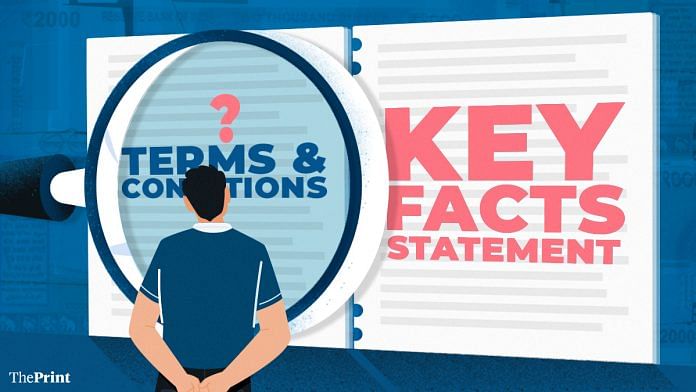Imagine you are at a supermarket trying to purchase a packet of biscuits. You can see all the different ingredients in the biscuits, but you don’t know what they mean for your health. The nutrition label tells you what which nutrient you are ingesting and in what amounts.
A ‘Key Facts Statement’ does something similar with the loan you plan to take.
What is a Key Facts Statement?
The Key Facts Statement (KFS) is usually a simple, page-long table containing a snapshot of the key information about a loan. Lenders offer loans with different terms and conditions (T&Cs), which contain important information the customer must know — like the identities of the lender(s), pricing, tenure etc.
However, this information can get lost in the lengthy, wordy, and technical provisions of the T&Cs document and the loan contract.
The KFS culls out and consolidates this information for customers to see briefly.
The KFS is a standardised document across lenders, based on templates given by the Reserve Bank of India (RBI). The RBI’s guidelines on digital lending, for instance, need the KFS to specify details like the loan amount, the tenure, the rate of interest, the repayments due, other fees, and penalties a customer might incur, details about third parties involved in the contract, details of the grievance redress officer, the cooling-off period etc.
Similarly, the Master Direction on Credit Cards asks card-issuers to disclose information about credit card limits and billing cycles.
By summarising and simplifying key information into a single table, the KFS plays an important role in protecting customer interests.
Also read: Why financial service providers, policy makers must evolve to better serve low-income households
Why is the KFS important for a customer?
The main objective of the KFS is to help customers better understand a loan.
Our research suggests that customers can find reading and understanding long-form T&Cs taxing and difficult. They may also prefer to only skim through T&Cs without fully understanding what they mean. As a result, customers may end up borrowing loans that do not suit them.
For example, the repayment tenure may be too short, or the rate of interest may be too high for the income the customer earns. Or the lender may be charging high fees for processing the loan application or for closing the loan in advance. Or the loan amount and disbursements may fall short of what the customer needs.
The KFS serves two important purposes in this regard.
First, it significantly reduces the time and mental bandwidth customers need to understand the loan product. By only presenting relevant information, the KFS allows customers to easily assess if they can afford the loan a lender is offering and if that loan fulfils their needs.
Second, just like nutrition labels on biscuit packets help us compare biscuits, the KFS helps customers compare different loan products more easily. Distinguishing between products by reading longer form T&Cs is a near-impossible task.
Such a task could in fact nudge customers to forego due diligence and choose the most appealing product, even if may not be suitable. A KFS simplifies the task by allowing customers to compare relevant details between different loan products — helping them filter loans that seem better suited to their needs.
How different are KFS from other loan documents?
The KFS is much simpler in form and content than other loan-related documents — like the general T&Cs document, the loan contract, and the privacy policy. As a result, the depth of information offered by the KFS can be shallow compared to what the other documents offer.
Longer form T&Cs often contain important nuances and details not captured by the KFS. These nuances can change how suitable or unsuitable the loan product may be for the customer. For example, some T&Cs may specify that the lender can cancel the customer’s loan at any point and demand immediate repayment of dues. Such an eventuality could be costly to the customer.
Similarly, lenders may change figures (like interest rate or repayment tenure) in the loan contract from what was mentioned in the KFS after making credit assessments about the customer.
Sometimes, the KFS may also be poorly implemented and omit information they should ideally capture. For example, KFS could omit important details like pricing and penalties, opposing what is specified in regulations. Cross-checking the longer form T&Cs can reveal such gaps in the KFS.
In summary, irrespective of what is mentioned in the KFS, it is important that customers review information in the loan contract before signing the agreement. The KFS is important in helping customers understand a loan product at a glance. But only relying on the KFS to borrow a loan, without understanding the finer details, can be risky.
Srikara Prasad is Policy Analyst at Dvara Research.
The article is part of our series of financial explainers in partnership with Dvara Research.
Views are personal.
Also read: Suitable or unsuitable? Understanding the role of credit in finances of low-income households



